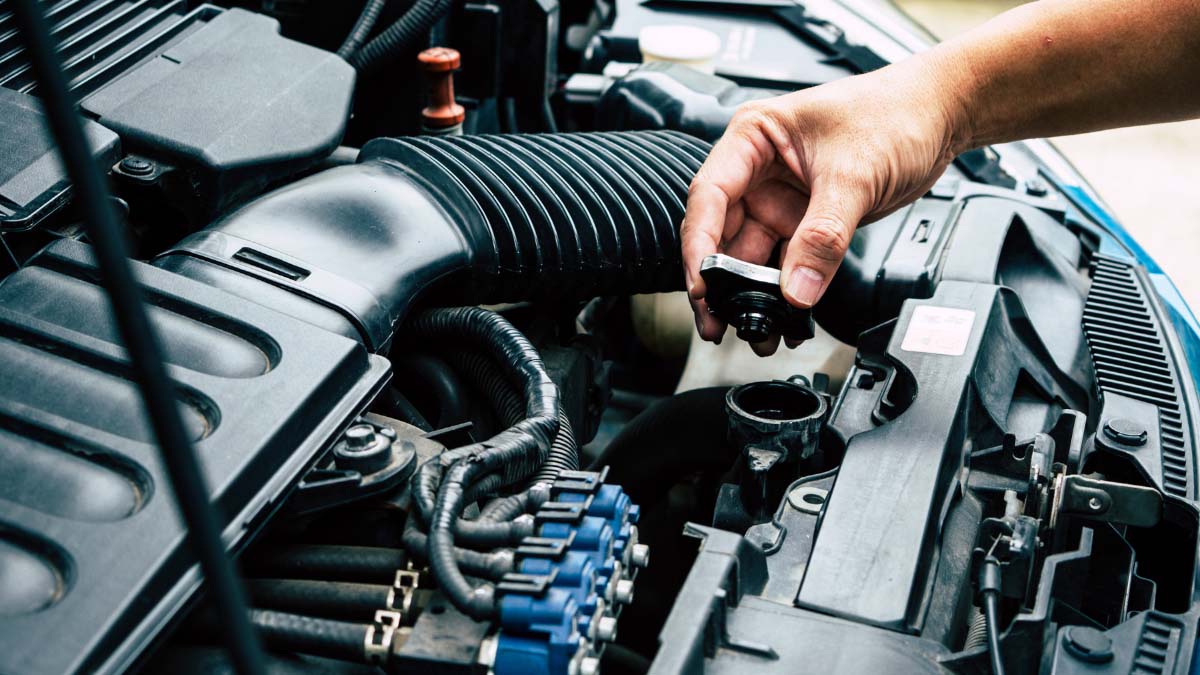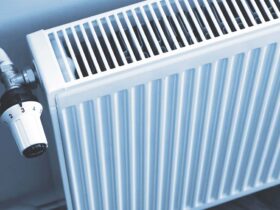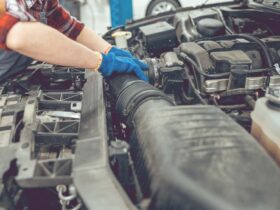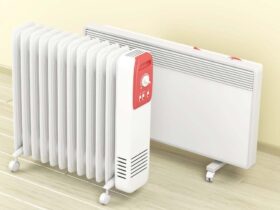A radiator capping seals the cooling system and maintains pressure. It ensures the system runs efficiently by raising the boiling point of coolant.
A radiator cap is a crucial component of a vehicle’s cooling system. It plays a vital role in managing the pressure within the system, which in turn helps in increasing the coolant’s boiling point. This results in better heat absorption and prevents the car from overheating.
The cap’s design allows it to release excess pressure when necessary to prevent damage, ensuring the cooling system operates within safe thresholds. Regular checks on the radiator cap can prevent leaks and overheating issues. Car owners should consider the cap’s pressure rating for compatibility with their vehicle to maintain optimal performance. With a proper sealing cap, the likelihood of coolant evaporation is reduced, which is essential for long-term engine health.
Introduction To Radiator Capping
Your car’s radiator cap may seem small, but it holds great importance. It helps maintain the right pressure in your cooling system. This ensures your engine does not overheat. Get ready to understand why this cap is a key player in your car’s well-being.
The Role Of A Radiator Cap
The radiator cap seals the system and keeps coolant from escaping. It manages pressure for optimal performance. The cap’s spring-loaded valve balances pressure. It ensures the engine runs within a safe temperature range.
- Maintains pressure: Seals the system, keeping the coolant inside.
- Prevents boiling: The higher pressure raises the boiling point of coolant.
- Allows overflow: Excess pressure is released to an overflow tank.

Basics Of Engine Cooling
Your car’s engine produces heat. Without cooling, it would damage itself. The cooling system dissipates heat. Coolant absorbs engine heat and carries it to the radiator. The radiator then cools the coolant.
| Part | Function |
| Engine | Generates heat |
| Coolant | Absorbs heat |
| Radiator | Dispels heat |
A working radiator cap is vital for this process. Without it, the coolant could boil over. This harms the engine.
How A Radiator Cap Works?
Under your car’s hood, a simple device keeps your engine cool. This unsung hero, the radiator cap, might look small, but its job is huge.
Pressure Regulation In The Cooling System
The radiator cap makes sure your engine stays at the right pressure. It acts like a guard, watching over the cooling system.
- At first, coolant heats up and expands.
- The cap senses the extra pressure.
- It opens slightly to let some steam out into the reservoir tank.
- When cooling down, it sucks coolant back in, keeping things balanced.
Preventing Coolant Evaporation
Keep the coolant in, that’s what the cap does. It stops the coolant from turning into vapor and leaving the system.
- The cap creates a tight seal.
- It keeps the system closed so no coolant escapes.
- Your engine stays safe and works like a charm.
Materials And Design
The right material and design for a radiator cap is crucial for maintaining vehicle performance. Caps must withstand high pressure and temperature. They also need to fit perfectly to prevent leaks. In this section, let’s explore the various metals used in radiator caps and how their seal and spring mechanisms contribute to a functioning cooling system.
Types Of Metals Used
Radiator caps are made from durable metals. Choosing the correct metal is vital for cap longevity. Here are some common metals used:
- Brass: Resists corrosion, handles high temperatures.
- Aluminum: Lightweight, conducts heat well.
- Stainless Steel: Strong, reliable under stress.
Seal And Spring Mechanism
The seal and spring mechanism are key components of a radiator cap. They work together to maintain system pressure. Below is a breakdown of their functions:
| Component | Function |
| Seal | Prevents coolant leakage. |
| Spring | Controls pressure levels. |

Pressure Ratings Explained
Understanding the pressure ratings of radiator caps is crucial for the health of your car’s engine. Essentially, they maintain the right pressure level within the cooling system, which affects your vehicle’s temperature regulation. Now, let’s delve into the details to figure out why hitting that pressure sweet spot matters so much.
Importance Of Correct Pressure Ratings
A radiator cap with the right pressure rating ensures a sealed system. This allows the coolant to properly flow. It keeps your engine at the best temperature. The right cap prevents boiling over and coolant loss. Think of it as a guard; it keeps your engine safe.
- Maintains proper coolant circulation
- Prevents overheating
- Guards against engine damage
Consequences Of Incorrect Pressure Caps
Use the wrong cap? Expect trouble. A cap with too low a pressure rating can lead to coolant boiling over. Your engine gets too hot. A high-pressure cap might not release excess pressure. This could crack the radiator. Both lead to costly repairs. Here’s what could happen:
| Pressure Rating Too Low | Pressure Rating Too High |
| – Coolant leaks | – Damaged seals |
| – Overheating engine | – Cracked radiator |
| – Head gasket failure | – Hose rupture |
Radiator Cap Maintenance
Radiator cap maintenance is crucial for your vehicle’s cooling system. A small but mighty component, the radiator cap keeps the cooling system pressurized and working effectively. Regular checks ensure it functions properly, avoiding engine overheating.
Inspection And Testing
Proper inspection and testing of your radiator cap are vital. Start by examining it visually. Look for cracks or wear on the seal. A poorly fitting cap can cause leaks. Ensure the spring action is strong; a weak spring could mean it’s time for a replacement.
Testing the cap often requires a pressure tester. This device checks if the cap holds the necessary pressure. A radiator cap that fails to maintain pressure can lead to engine overheating and reduced engine performance.

Signs Of A Failing Radiator Cap
Signs of a failing radiator cap should never go ignored. Watch out for the following indicators:
- Coolant leaks: Spot coolant near your car? Check your cap.
- Engine overheating: A malfunctioning cap often leads to overheating.
- Swollen reservoir hose: This could signal excess pressure.
- Collapsed radiator hose: Indicates vacuum issues linked to the cap.
- White streaks: These on the radiator neck could mean a leaking cap.
At the first sign of any issues, consider professional help.
Replacement And Installation
Time for a change under the hood? The radiator cap is a small component with a big role. Proper installation ensures a snug fit, preventing coolant leaks and keeping the system pressurized. Whether you’re an experienced DIYer or a novice, replacing your radiator cap is a straightforward task you can tackle with confidence. Let’s make sure your vehicle stays cool under pressure!
Choosing The Right Cap
Not every cap fits every radiator. Picking the right cap is crucial. Here’s how to make the perfect match:
- Check your manual: It knows best. Find the cap specifications you need.
- Look at the rating: Match the pressure rating recommended for your car.
- Inspect the gasket: The seal should be flexible and free of cracks.
Step-by-step Installation Guide
With the right cap in hand, you’re set for installation. Follow these steps and keep your cool:
- Prep Work: Make sure the engine is cold.
- Remove Old Cap: Press down and twist counterclockwise.
- Inspect and Clean: Wipe the radiator neck for debris.
- Place New Cap: Position, press down, and twist clockwise.
- Double-check: Ensure it’s secure and tight.
- Test: Start the car and check for leaks.
Troubleshooting Common Issues
Radiator caps play a crucial role in your car’s cooling system. They keep the engine’s temperature in check by managing pressure. But sometimes, they fail, leading to various problems. Recognizing common radiator cap issues is key to a well-functioning vehicle. Let’s explore some of these problems and learn how to fix them. Remember, a healthy radiator cap means a happy engine!
Overheating And Pressure Loss
When a radiator cap can’t maintain pressure, overheating occurs. This is because the cap keeps the cooling system sealed under pressure, raising the coolant’s boiling point. Watch out for these signs:
- Coolant boiling over – means your cap might not hold pressure well.
- Engine temperature spike – a faulty cap causes your engine to run hotter.
- Steam from the hood – signals an overheated engine.
To fix overheating and pressure loss:
- Confirm the cap’s pressure rating matches your vehicle’s specifications.
- Check the cap’s seal for cracks or damage. Replace the cap if needed.
- Ensure the radiator overflow tank is functioning correctly.
Leakage And Corrosion Concerns
Poor radiator caps can lead to coolant leaks and corroded parts. Signs include:
- Visible coolant leaks – often found near the cap.
- Deposits or rust – look for these on the cap or nearby.
- Low coolant levels – without a visible reason, suspect the cap.
To address leakage and corrosion:
- Clean any debris or deposits from the cap and surrounding area.
- Inspect the cap for rust or corrosion damage. Replace if necessary.
- Make sure the rubber gasket on the cap seals properly and isn’t worn out.

Performance Enhancements
Exploring radiator capping reveals secrets to boosting car performance. This vital component affects how vehicles handle extreme conditions. Understanding its role in engine management leads to significant gains on the track and the street.
Upgraded Caps For Racing
Racing demands peak vehicle performance. Standard radiator caps don’t always suffice. Racers often upgrade to higher-pressure caps. These caps enable the cooling system to operate at greater pressure. This effectively raises the boiling point of the coolant. It ensures the engine runs cooler during high-speed endeavors. Upgraded caps result in consistent performance and increased durability.
- Better temperature regulation during intense races
- Improved engine cooling under stress
- Higher pressure threshold, reducing the risk of overheating
Impact On Engine Efficiency
The right radiator cap does more than prevent overheating. It plays a crucial role in engine efficiency. A well-sealed system maintains proper pressure. It allows the engine to reach optimal operating temperatures swiftly. This creates a more complete fuel burn. Enhanced efficiency leads to better fuel economy and power output.
| Factor | Benefit |
| Optimal Pressure | Improved Compression |
| Proper Sealing | Reduced Coolant Loss |
| Efficient Fuel Burn | Increased Power and Economy |
Engine longevity benefits from consistent operating conditions. Better sealing means less stress on engine components. The upshot is a reliable ride. Cooler operating conditions extend the life of the engine. For performance enthusiasts, these enhancements are critical.
Regulatory And Safety Considerations
The importance of radiator caps often goes unnoticed, but they are a critical component of your vehicle’s cooling system. Understanding regulatory and safety considerations is essential for maintaining performance and ensuring safety on the road. High-quality radiator caps must meet specific standards, and they require proper handling and disposal to prevent harm to both people and the environment.
Compliance With Standards
Radiator caps must comply with safety standards to ensure they function correctly and to avoid accidents. Different regions may have varying requirements, but common standards include pressure rating consistency, material quality, and durability.
Manufacturers and sellers must adhere to these guidelines:
- ISO certifications for quality management and safety
- Pressure specifications conforming to vehicle recommendations
- Consistent product testing for reliability and performance

Safe Handling And Disposal
When removing or attaching radiator caps, always wear protective equipment. Removing a cap from a hot engine can cause severe burns.
Let the engine cool down first:
- Turn off the engine and wait for cooling
- Use thick gloves to protect your hands
- Twist off the cap slowly to release any pressure
Safe disposal of radiator caps is crucial:
- Consider recycling if the material allows
- Dispose of damaged caps in accordance with local regulations
- Avoid dumping with general waste due to potential chemical exposure
Maintain safety and regulatory adherence with every use and disposal of radiator caps.
Frequently Asked Questions Of Radiator Capping
What Is Capping Off A Radiator?
Capping off a radiator involves sealing the radiator’s valve with a cap, effectively stopping water flow and isolating it from the heating system for maintenance or removal.
What Do Radiator Valve Caps Do?
Radiator valve caps seal and protect the valve, preventing leaks and blocking debris from entering the system. They ensure safe and efficient radiator operation.
How Do I Know If My Radiator Cap Is Bad?
A bad radiator cap can exhibit several signs, including coolant leaks, an overheated engine, or collapsing radiator hoses. Check for steam or coolant fluid near the cap, and if the seal appears cracked or damaged, replacement is necessary.
Are Radiator Caps Universal?
Radiator caps are not universal; they vary in pressure ratings and sizes to match specific vehicle cooling systems. Always check for compatibility with your car model before purchasing a replacement cap.
What Is A Radiator Cap’s Function?
A radiator cap seals the cooling system and maintains pressure, which raises the boiling point of the coolant for efficient heat dissipation.
Conclusion
Wrapping up, mastering radiator capping is crucial for vehicle upkeep. It’s a simple yet vital step to ensure engine longevity and efficiency. Remember, selecting the right cap and routine checks can prevent costly repairs. Keep your ride smooth and your engine cool by giving radiator caps the attention they deserve.
Drive safe!






Leave a Reply